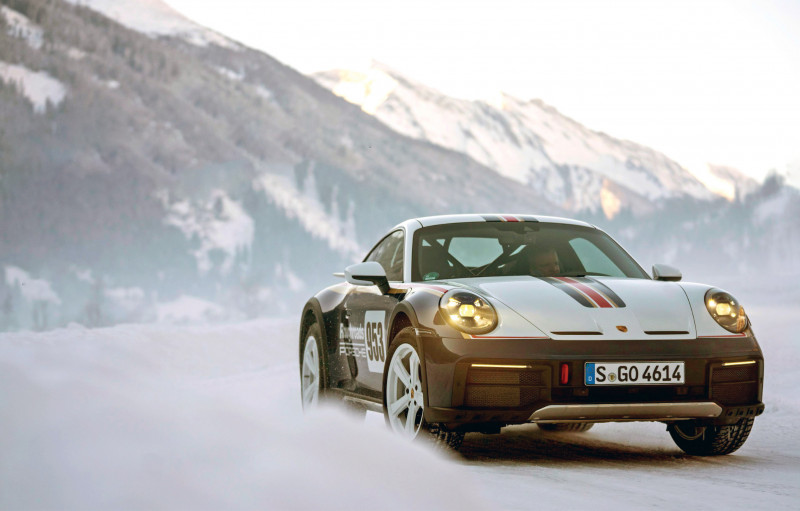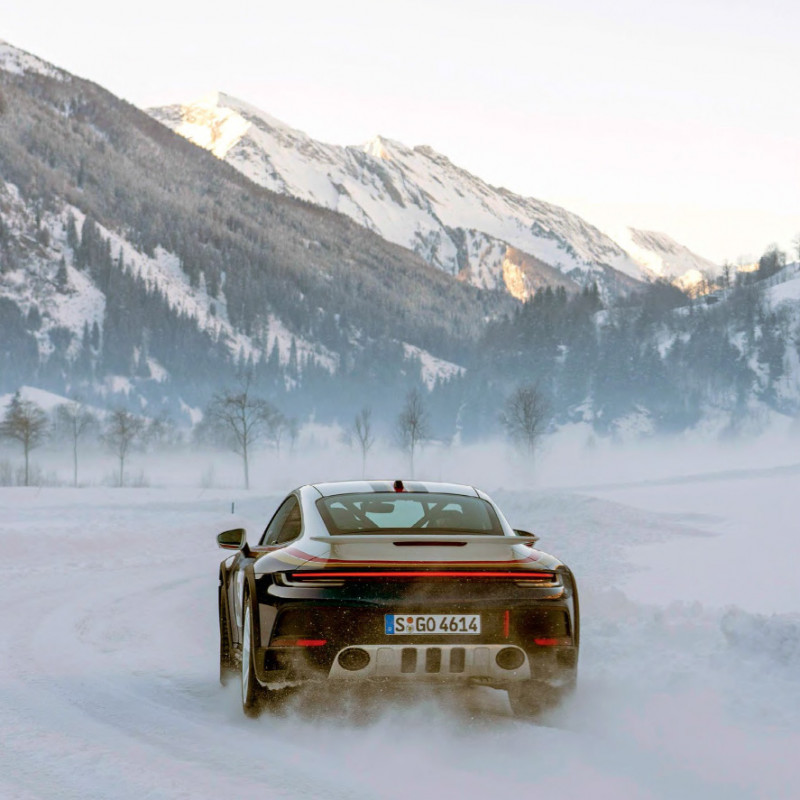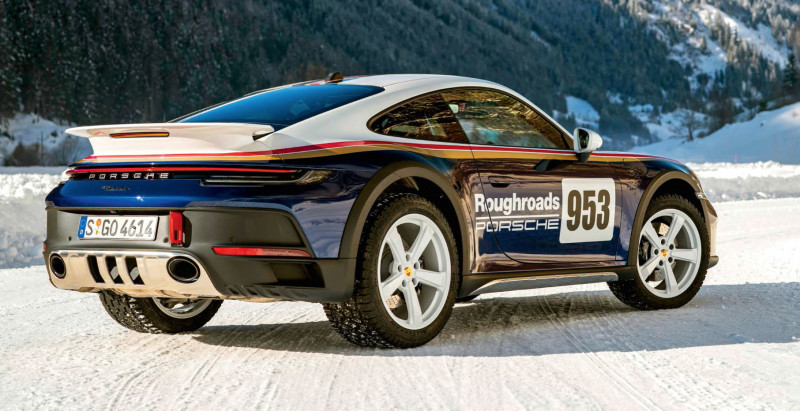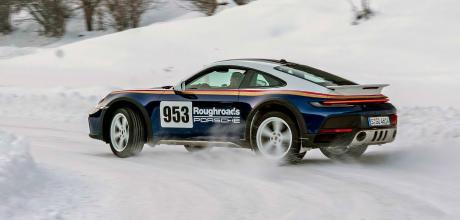New 2024 Porsche 911 Dakar 992 first drive
Porsche has unleashed its first fully off-road Neunelfer, so how does it drive over uneven terrain? Total 911 reviews the new Dakar on ice…
PORSCHE’S FIRST PURPOSE BUILT 911 FOR OFF-ROADING TESTED… ON ICE!
New 911 Dakar first drive
It’s the first production 911 to be built specifically for off-road use. We take it for a drive on ice at Zell am See, Austri
Apparently, the idea for an off-road 911 was first explored with the 991. Development reached the point of running prototypes, but the management got cold feet and the project stalled.
It’s me who’s got the cold feet today, though. That’s because I’m standing on the ice track at the Winter Fahr Training centre in Muhr, Austria. It’s evident that the management’s concerns were finally overcome. The 911 Dakar is a production reality – albeit one that’s limited to a run of just 2,500 cars – because there are several of them in front of me. Total 911 has been referring to it for some time as the Safari, and the low-down is that Porsche had intended on calling its new all-terrain 911 exactly that. And this was the case until Indian automobile manufacturer TATA objected, stating that it had the rights to the name for one of its SUVs.

Dakar it is, then, and it’s apt, given Porsche’s history at the famous rallying event. You’ll likely know that the 911 Dakar is based on a Carrera 4 GTS Coupe, although the specification sheet reveals details that you won’t find among any other 911 technical data. There’s talk of ramp angles and ground clearance – 16.1 degrees and 161mm (191mm raised) for the number crunchers among you – as well as the breakover angle of 19 degrees, which is in the realm of SUV rather than sports car. Thank the raised suspension for that. The PASM gains 50mm in height under regular conditions and can be raised by a further 30mm on both axles should you need it, at speeds up to 105mph, or 170km/h.
“The Dakar feels incredibly sure-footed. That’s down to a combination of the four-wheel drive allied to the literal black magic of a proper winter tyre”

Will you need it, though? That’s the question plenty of people have been asking since the Dakar was first revealed. A few more cynical commentators have suggested Porsche is plundering its rallying history to create a new, expensive 911 derivative that’s destined to gather dust in collections rather than deserts. Of course, what buyers do with their cars is out of Porsche’s hands, so it’s concentrated on engineering the Dakar with the same exhaustive, obsessive attention that means even if most won’t, they certainly could…

The suspension is just the start of it. The Dakar is only for a driver and passenger, or perhaps more correctly co-driver, because the hydraulics required to lift the back axle means rear seats are nowhere to be seen. There’s weight in that lifting system, which is essentially the same kit as the optional front axle lift kit available elsewhere in the range, only modified with higher-capacity pumps to cope with the greater pressures the Dakar demands. There’s more mass too, thanks to the necessary addition of extensive underbody protection, as well as the Dakar’s more overtly scuff-resisting body addenda around the wheel arches, bumpers and sills, the permanent tow hooks painted in red, and heavier off-road tyres.
To offset some of that bulk Porsche has raided the weight-reducing cupboard. The GT3 donated its bonnet, the rear spoiler is now fixed and produced in the lightweight weave, and there’s thinner, lighter glass and a lightweight battery. Climb inside and the standard seats are the full carbon-fibre bucket items. Adaptive, 18-way electrically adjustable Sports seats are also available. There’s the option of a carbon roof if you want it, which could be used to offset some of the weight you might want to add with the optional Rallye Sport Package. This pops a cage in the rear, as well as including a fire extinguisher and six-point racing harnesses to be fitted by yourself.
The stock tyre for the Dakar has been developed by Pirelli. Its Scorpion All-Terrain Plus tyres are standard fit on the 19-inch front and 20-inch rear wheels (both dropping an inch over the GTS). These feature a 9mm tread depth and aggressive chunky pattern, as well as twin carcass plies and reinforced sidewalls to ensure they provide high cut and puncture resistance. If you’re a little less adventurous then there’s a choice of P Zero summer or full winter tyres, should you want them.
There’s also the option of a neat roof-rack for the ultimate adventure look. Its integrated lights, which are only to be used off-road and require covers while on-road, sees the Dakar coming with a roof-mounted power outlet. The button for those 2,600 lumen lights is situated in the roof console by the rear-view mirror, with the lights connecting to the roof power via a magnetic socket. Porsche charges a not in significant £4,300 for that rack, and if you’re still feeling flush then it will happily sell you all manner of recovery boards, canisters and folding spades, and the necessary fixings to strap it all above your head.
If you’ve bought the fully loaded roof-rack you might want to go all-in with the off-road trappings and pick one of the homage livery schemes. The option that resembles the Roughroads 953 and 959’s livery features a Gentian blue metallic and white body, with a lofty £18,434 price tag to match. The other rally-style packages give a reverential nod to Porsche’s 1971, 1974 and 1978 exploits in African safaris. These are adhesive sets and so are a cheaper purchase, with the 1971 and 1974 styles costing a fraction under £3,000. The more complex Martini stripes of 1978 are a cut above the rest at £4,209. Eye-catching as those packages are, the Dakar arguably looks best without them. The Dakar-exclusive Shade green metallic is a particularly appealing choice; that hue is the default contrasting stitching in the standard Race-Tex-adorned interior.
At the Dakar’s nose the active flaps have been binned in favour of fixed intakes with grilles, because they’d be prone to damage off-road. Indeed, Porsche has had a substantial re-think for the engine’s cooling. The central front radiator has been removed to improve front ground clearance, and the higher-capacity radiators from the Turbo S have been installed as well as their more powerful fans to draw air through them. The system also has improved sealing to cope with the increased dust the Dakar may or may not encounter. The result of all that is that the Dakar weighs in at 1,605kg. That’s just 10kg greater than a PDK-equipped Carrera 4 GTS Coupe.
Cooling’s not an issue today, with a minus symbol in front of the outside temperature reading. Unsurprisingly, the Dakars here are wearing the P Zero winter tyre, not the full-blown, knobbly standard tyre, with the Pirellis finding incredible traction in the low-grip conditions. We have the opportunity to attempt to break that hold thanks to 473hp from the turbocharged 3.0-litre flat six, with the snow and ice track revealing Porsche’s successful efforts in its tuning and calibration of the drive systems, with some Dakar-specific modes.
Turn the wheel-mounted drive mode dial and there’s the usual selection up to Sport. Sport+ has been replaced with Rallye, and after that comes Offroad. Rally champion Walter Röhrl’s on hand to explain the differences in the modes, which is handy because he helped to develop them. Rallye is more rear-biased and enables a higher threshold with the PSM (Porsche Stability Management) system. Meanwhile, Offroad is focused on traction, divvying up the power more readily across the axles to find the best means of progressing forwards. Starting in Normal, with PSM on, the Dakar feels incredibly sure-footed. That’s down to a combination of the four-wheel drive allied to the literal black magic of a proper winter tyre.
It’s fun, too, with the car feeling balanced and secure. Yet there’s much more fun to be had once the driving mode has been changed to Rallye for a more playful rear end. Any 911’s a joy (with the right tyres) on snow and ice. The Dakar’s no exception, but its off-road specification means it feels less incongruous in such conditions. The Rallye mode loosens it up, and a quick flick to Offroad really does demonstrate the shift in drive. It reins in the playful rear and shifts a lot more drive to the front axle. That might be useful if you’re crawling up a mountainside or crossing a tricky river, but on the snow its surefootedness, while impressive, isn’t the most grininducing of the possible drive modes.
On Walter’s suggestion I switch it to Sport and PSM in Sport, which gives me all the control I want, with the reassurance that there’s some electronic Röhrl-derived algorithms giving a helping hand if required. Doing so makes for a hugely entertaining drive. The stability control gives plenty of wheel slip and enables the 911 to use its weight distribution to good effect. A lift tucks the nose in, with a quick stab of the accelerator seeing the lightened rear axle slip and rotate, with ever-increasing slip angles possible.
The deep clutch of the standard carbon bucket seats is certainly welcome when the Dakar’s rear axle is doing the majority of the steering by using the accelerator. The 3.0-litre turbo engine’s ideal for this situation. Like the driver in the bucket seat, it’s held tightly in place by GT3 engine mounts, and its low torque is perfectly suited for off-road traction. Similarly, the ample ratios of the slick-shifting PDK transmission mean there’s never any interruption in the traction.
It all sounds fantastic, too, with the thinner glass, lack of rear seats and a standard Sports exhaust filling the cabin with a purposeful resonance that’s got more than a hint of competition car about it. It’s all very impressive. The commitment of Porsche’s engineers to development above and beyond the most extreme case uses is evident and perfectly executed, even if the likelihood is that the Dakar will rarely, if ever, be placed in such situations. If Porsche’s customers will own supremely over-engineered cars, then so be it. Likewise, if it means the development engineers get to outrun their Cayenne workmates up the steepest of dunes in desert test driving thanks to the car being lighter and lower, then that’s another win for the 911. And a good one, too, with the Dakar bookending the 911 line-up and delivering even greater bandwidth in an already extensive range.
It’s not all about ice and snow driving either, because the Dakar’s our transport back to the Porsche family’s home of Zell am See, where we’ll be overnighting. Off the snow and on the smooth tarmac of Austria’s roads, any expectation of increased tyre noise doesn’t materialise. Indeed, in relation to road noise the winter Pirelli tyres are surprisingly quiet – that lack of rumble perhaps a result of the softer compounds as well as the greater compliance that comes from the higher suspension system. On the road it rides beautifully. The standard PDCC suspension system keeps body roll and pitch and dive in check, which is impressive. And yet a little more body movement from the Dakar might actually be desirable to – height aside – further differentiate it from a standard Carrera.
On the brief road drive the Dakar’s dynamics don’t appear to be compromised by its requirement to venture into the wilds. The recalibrated steering is still fine in its weight and accuracy, with the turn-in and manoeuvrability aided by the standard fitment of rear-wheel steering. The performance is affected, on paper at least, with the Dakar taking 3.4 seconds to reach 62mph from standstill. This is marginally slower than a regular PDK-equipped Carrera 4 GTS by just 0.1 seconds. It’ll reach 62mph in around four seconds on gravel though, which mitigates its tarmac ‘tardiness’ against the clock. Where it loses out most is where it really doesn’t matter. Its 148mph (240km/h) top speed is limited thanks to the off-road spec tyres, which makes it not only the slowest 911 a lot of money can buy (prices start at £173,000), but among the slowest Porsches in the model line-up.
You’ll not care one bit, because while every other 911 (and indeed every other current Porsche save a few base model Macans and Taycans) speed along the Autobahn at greater velocity, the Dakar’s abilities enable it to chase all-new horizons almost impervious to what’s under its tyres. Furthermore, as one insider revealed, during testing the Dakar was setting times around the Nürburgring that bettered those of the 996 GT3 RS, which means under eight minutes and, no doubt, some inventive lines across the raised kerbs to maintain speed.
That, as much as anything, underlines the progress Porsche has made in every area with the 911’s development. It also demonstrates that the Dakar, while increasing the 911’s capability in one area, won’t see it lose out on its core appeal as a proper sports car. It’s just one that’s more capable in any environment, more desirable and certainly more driveable. This quite possibly makes it the perfect modern 911, and the perfect, real SUV.
The 911 in rallying
No one is ever going to accuse Porsche of failing to exploit every possible niche with the 911, and there’s no better representation of that approach than the 911 Dakar. It’s certain to be divisive, but it’s not without some historical justification. 911s have been rallied since it was introduced – not forgetting the 356 before it, either.
Porsche’s rallying exploits have seen the company amass a respectable haul of silverware for the corporate trophy cabinet. Vic Elford won at the Monte in 1968 in a 911T, and Björn Waldegård confirmed Quick Vic’s and the 911’s win was no fluke by taking the wins again in 1969 and 1970 while driving a 911S.
In typically Porsche fashion the company looked for tougher challenges for its rally 911, and Africa presented them. 911s would compete in the East African Safari Rally, a 5,000km race held in Kenya. A 911 took fifth place in 1971 and second place in both 1974 and 1978.
Around the same time Porsche was developing a four-wheel drive system that it had shown with the 911 Turbo 3.3 4x4 Cabriolet Studie at 1981’s Frankfurt Motor Show. Jacky Ickx, the four-time Le Mans winner, saw prototypes testing at Weissach and suggested entering the Paris-Dakar with an all-wheel-drive 911. The Porsche 911 Carrera 3.2 4x4 Paris-Dakar was the result (less cumbersomely known as the 953). Porsche would enter three cars in the 1984 race, with René Metge and co-driver Dominique Lemoyne taking the win in the 225hp, 1,215kg car. The 911’s light weight, ample power and traction advantage thanks to its engine position helped it to win the gruelling rally raid.
The 953 was successful, but short-lived. It was replaced with the Group B 959 in 1985, with Porsche fielding three cars for Paris-Dakar, although its quick development meant they were running 911 engines and didn’t finish the event. After testing and a few shorter rallies, Porsche entered the 1986 event with three cars, and this time it was properly prepared. The cars finished first, again with René and Dominique, with Jacky and Claude Brasseur taking second. Weissach engineers Roland Kussmaul and Hendrick Unger brought in the third car, which provided support for René and Jacky, in sixth position.
Legend cemented, Porsche bowed out of rallying as a factory concern, but those wins and cars resonate to this day.
ABOVE The 911 Dakar’s 3.0-litre flat six can achieve 473hp, and reaches 62mph in just 3.4 seconds ABOVE The Dakar’s stock tyre choice is Pirelli’s Scorpion All-Terrain Plus tyres, or P Zero summer or winter tyres.
ABOVE A close-up of the £18,434 colour option that resembles the Roughroads 953 and 959’s livery.
LEFT There’s room for a passenger in the Dakar’s cabin, but the rear seats have had to make way for a hydraulics system to lift the back axle.
ABOVE The Porsche Dakar has a quoted maximum ground clearance of 161mm.
Right Choose between carbon fibrereinforced plastic (CFRP) bucket seats, or 18-way adjustable Sports seats


